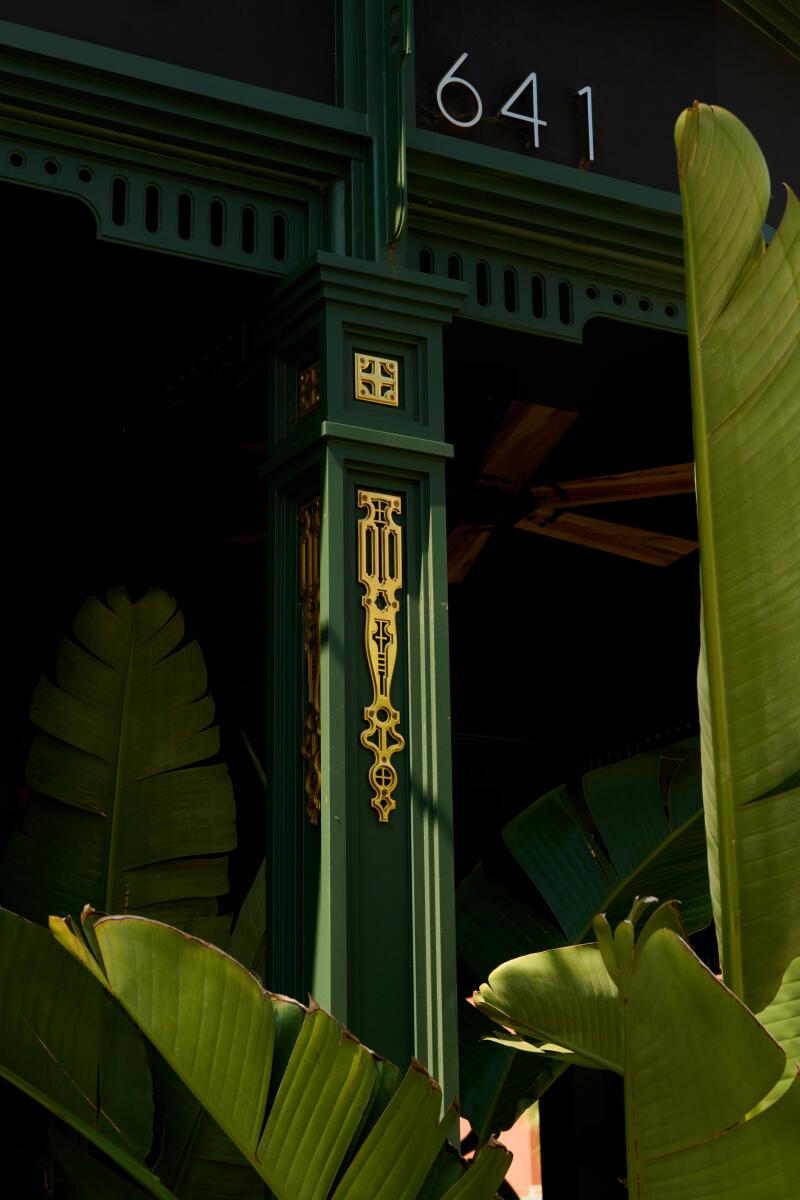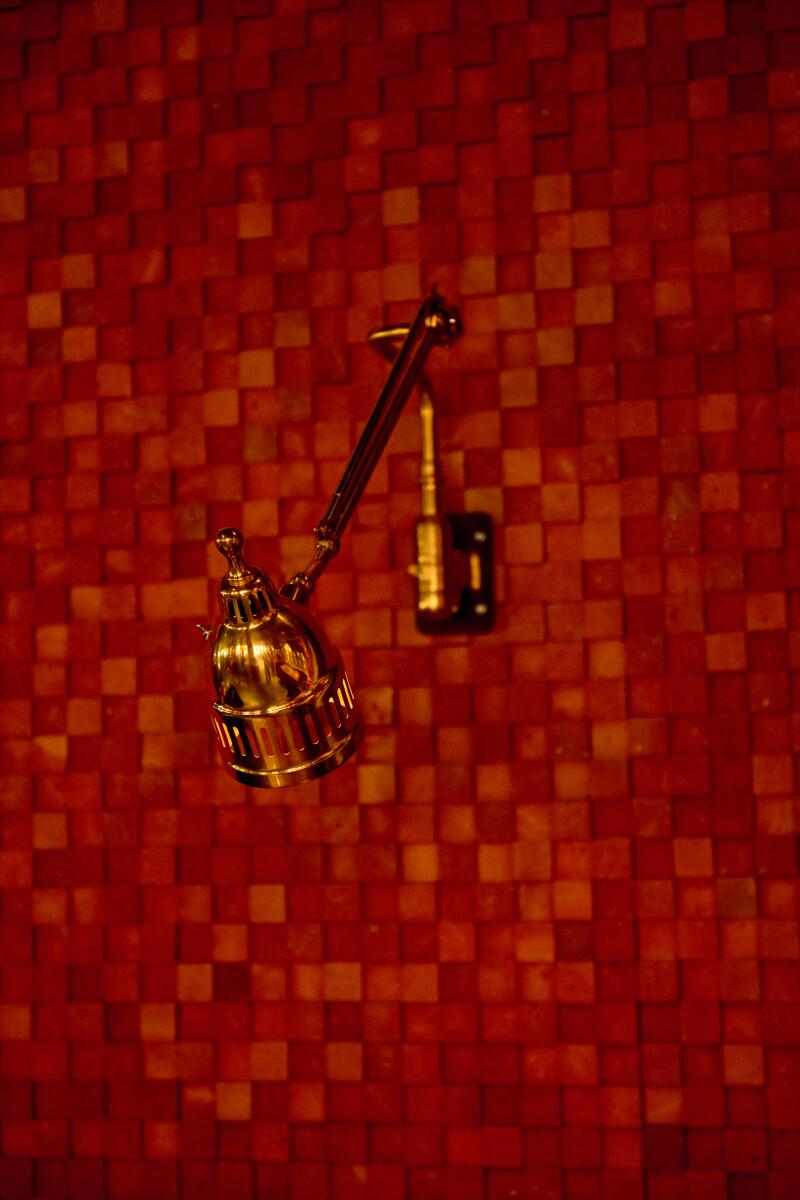The contradictions surrounding the Asian chain Star Leaf start with the official number of locations: There are 43 restaurants around the globe. Wait, no. Forty-five. Most of them are in China. One might have a Michelin star. The woman who founded the restaurants is an interior designer who designed all 45 locations. Actually, each location has its own design team. The recipe for the Royal Crown fried rice, the restaurant’s signature dish, was purchased after the founder saw the rice in a movie and tracked down the chef who created it. Hold on. It’s 43 locations.
The myth-making that surrounds the new Star Leaf in Pasadena, the chain’s first U.S. restaurant, rivals that of the Loch Ness Monster. The story shifts and flips depending on whom you ask, and when. Maybe the staff plays a game of telephone before service.

The exterior of Star Leaf.

A light fixture against Star Leaf’s red brick interior.

Royal Crown fried rice with white and black jasmine rice shaped in a circular mold with chopped shrimp, scallops and green onions. On top is a sheet of wild Icelandic capelin fish roe.
So I set out to get a handle on this enigma of a restaurant that the ladies in my mom’s mah-jongg group have been curiously chatting about since it opened in the former Roy’s space on Colorado Boulevard in April.
I also was intrigued by some recent online drama. Yelp disabled comments on the restaurant’s page weeks ago, referencing an increase in activity, racism and need to investigate the content. According to a Reddit thread, the Yelp activity was prompted by an influencer who was refused a comped bottle of expensive wine and then accused the restaurant staff of being prejudiced.
I had a notebook full of questions when I arrived for my first visit. The members of the design team, whomever they might be, successfully transformed the space into an upscale tropical oasis with jade green tiles along the floor, plush leather booths and seats that appear straight out of the Restoration Hardware showroom. According to the website, the dining room doubles as an art gallery, and all the artwork is for sale.
Dark wood with intricate molding lines the walls and tables, palm fronds sprout up from strategically placed planters and slatted window coverings complete the luxe Tommy Bahama vibes. It’s the Long Bar at Raffles Singapore re-imagined as a sprawling restaurant, complete with an indoor-outdoor fish pond that may or may not contain fish when you visit.
The first question you’re asked when seated is whether this is your first time. The server then launches into his or her version of Star Leaf lore. In my four visits, I received four versions, despite the server being the same twice. It’s Southeast Asian food with Thai and Cambodian influences. It’s Southeast Asian food that’s primarily Thai but with Malaysian influences. It’s all meant to be shared.
Regardless of the narrator, the information is delivered earnestly and with pride.



Malay Captain’s curry. Guests ordering inside Star Leaf. A table setting at Star Leaf.
The Royal Crown fried rice does appear royal. White and black jasmine rice is crammed into a circular mold with chopped shrimp, scallops and green onions. On top is a sheet of orange, wild Icelandic capelin fish roe. The kernels of black rice are pleasantly chewy. After a good mix, each bite is punctuated by the sweet marine, crunchy pops of roe. It’s just as enjoyable for lunch the next afternoon.
The dish your server will push more than all others is the Royal Thai Curry, a monstrous bowl of sauce accompanied by your choice of lobster, soft-shell crab or shrimp. The menu advertises that it comes with a baked baguette. During one visit, I was asked to choose between rice or bread. The warm baguette is toasted and soft in the middle, like the petite loaves you might find at your favorite banh mi shop. During all other visits, I was automatically given a bowl of white rice.
The gold sludge laps at the sides of the bowl on its way to your table, nearly spilling over the edge. It’s thick with what tastes like pureed potato, with not much spice and a slightly bitter aftertaste. Ribbons of egg dominate the curry like an egg drop soup. Was it meant to evoke the marbled sauce surrounding the chile crabs I ate at hawker centers in Singapore? According to the server, it’s “based on a traditional royal curry from Thailand.” After inquiring with a few Thai chefs around town, no one could decipher the origins of the curry or any ties to the monarchy of Thailand.
The recommended lobster tail got lost in the sauce, the muddy liquid possessing as much gusto as a dense Japanese curry, swallowing the nuggets of delicate shellfish. I ended up using the curry as a dip for my bread but found that I preferred the baguette on its own.
Soft-shell crab proved a far better match for the sauce. If you’re intent on curry for dinner, the red Rainforest Vegetable Curry is more robust, with a medley of well-cooked broccoli, Brussels sprouts and other vegetables and a slow burn that gains momentum with each spoonful. But there’s a failure to launch with all the curries and many of the sauces: The punch, spice and funk most associated with Southeast Asian cooking is absent.

Lime-steamed Chilean sea bass in a sauce of lemongrass and herbs at the new Star Leaf.

Banana leaf chicken with crispy skin.
Some of the variations on the more traditional Thai dishes, such as Crying Tiger, are unrecognizable. It’s offered as a salad with grilled chicken, steak or tofu. The strip steak will exhaust the most resilient of mandibles. On top, a sweet, whole-grain mustard sauce slides off the meat. On the side is a mound of green salad with wilted lettuce and curls of shaved Manchego cheese.
The skin on the banana leaf chicken is thin and brittle like Peking duck, crisp enough to eat like a chip. The meat beneath is disappointingly dry.
Chilean sea bass is steamed minutes past supple, firming the flesh to just overdone. It swims in an electric green sauce vivid with lemongrass, cilantro, chile and mint. This will become your go-to condiment for whatever else is on the table.

Mamasan’s shrimp cake skewers.
The kitchen is strongest with a fryer and dessert. Mamasan’s shrimp cake skewers are hunks of breaded and fried shrimp sausage, loose in construction and studded with crunchy watercress.
Squares of so-called Night Market tofu are breaded and fried in ground panko breadcrumbs, then dusted in a “Japanese 7 spice mix” that’s a dead ringer for Chinese 5-spice. Each piece is wonderfully crisp, with a coating that tastes like toasted cereal and a middle as soft as custard.
Dessert was consistently the most enjoyable part of the meal, the presentations often eliciting gasps from my table and those around us. The Pink Mekong is a spectacle meant for four, a raised silver bowl with dry ice smoke billowing out from the center. The server pours pink coconut cream over the top while the smoke dances over the table. Everyone digs in with a spoon, attempting to get a bit of each component, like a jumbo cup of halo halo. Strawberry and coconut ice creams hug a pile of red beans nestled next to sliced strawberries, diced green melon and a heap of lotus seeds. My favorite component may have been the peach gum, small amber nubs of a chewy, sticky substance I was told came from the sap of a peach tree. It’s all incredibly fun to eat.

A server pours pink coconut cream over the Pink Mekong dessert.
I was observing dry June and July for the majority of my visits and did not partake in the cocktails. But the fruit- (and curry-) infused concoctions served in fanciful glassware were seen on nearly every table. And I can think of far worse ways to spend an evening than with a plate of crunchy fried tofu and a Raffles Singapore Sling at the bar.
I may never know the true origins of the fried rice, or the exact number of locations. I’m still waiting on a reply from a restaurant representative. If you’re enjoying your dinner, I guess it doesn’t really matter. But the Loch Ness Monster has nothing on the mysteries of the Star Leaf in Pasadena.
Star Leaf
641 E. Colorado Blvd, Pasadena, (626) 345-5371
Prices: Appetizers $19-$49, entrees $19-$87, desserts $12-$28
Details: Open Monday through Thursday for lunch from 11 a.m. to 3 p.m. and dinner 5 to 9:30 p.m.; Friday and Saturday from 11 a.m. to 10 p.m.; and Sunday from 11 a.m. to 9 p.m. Full bar. Street parking.
Recommended dishes: Mamasan’s shrimp skewers, Night Market tofu and, for dessert, the Pink Mekong and the Tropical Panna Cotta Coconut Bowl.

